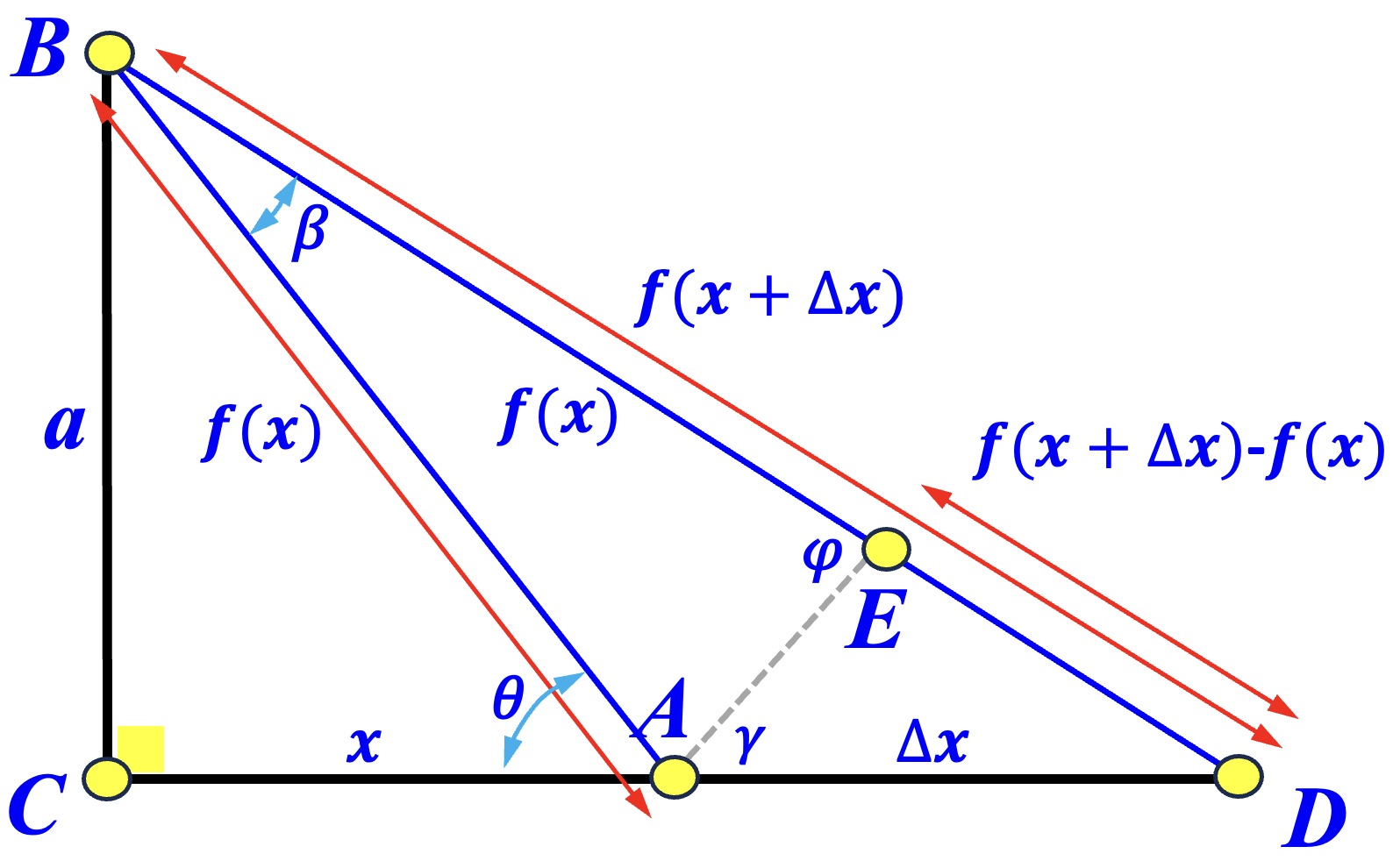A Simplified Version of Mike Staring's Proof
Ching-Kuang Shene (冼鏡光), Professor Emeritus
Department of Computer Science
Michigan Technological University
Houghton, MI 49931
USA
Created October 24, 2025
![]()
Ching-Kuang Shene (冼鏡光), Professor Emeritus
Department of Computer Science
Michigan Technological University
Houghton, MI 49931
USA
Created October 24, 2025
![]()
Staring's proof can be simplified using trigonometry. The following diagram is a simplified version of the one shown in Staring's proof. In right triangle \( \bigtriangleup ABC \), \( \angle C = 90^{\circ} \), \( a = \overline{BC} \) is a cosstant, \( x = \overline{AC} \) is a variable and the length of the hypotenuse \( f(x) = \overline{AB} \) is a function of \( x\). Let \( \theta = \angle BAC \). If \( x \) is increased by \( \Delta x \) so that \( \overline{CD} = x + \Delta x \) we have \( \overline{AD} = \Delta x \) and \( \overline{BD} = f(x+\Delta x)\). Let \( \alpha = \angle CDB \) and \( \beta = \angle ABD \), and let \( E \) be a point on \( \overline{BD} \) such that \( \overline{BE} = \overline{BA} = f(x) \). Thus, \( \overline{ED} = f(x+\Delta x) - f(x)\). In this way, we have \( \varphi = \angle AEB = 90^{\circ}-\frac{\beta}{2} \), \( \angle AED = 180^{\circ} - \varphi = 90^{\circ}+\frac{\beta}{2} \) and \( \gamma = \angle DAE = 180^{\circ}-\left( \theta + \angle BAE \right) = 180^{\circ} - (\theta+\varphi) = 180^{\circ} - \left( \theta + 90^{\circ}-\frac{\beta}{2} \right) = 90^{\circ} - \left( \theta - \frac{\beta}{2} \right)\).

Consider \( \bigtriangleup AED \). The Law of Sines gives \[ \frac{\overline{ED}}{\sin{\gamma}} = \frac{\overline{AD}}{\sin(\angle AED)} = \frac{f(x+\Delta x)-f(x)}{\sin(\gamma)} = \frac{\Delta x}{\sin\left(90^\circ+\frac{\beta}{2}\right)} \] As a result, we have the following: $$ \begin{eqnarray*} f^{\prime}(x) &=& \lim_{\Delta x\rightarrow 0} \frac{f(x+\Delta x)-f(x)}{\Delta x} \\ &=& \lim_{\beta \rightarrow 0} \frac{\sin(\gamma)}{\sin\left( 90^{\circ}+\frac{\beta}{2}\right)} = \lim_{\beta\rightarrow 0} \frac{\sin\left(90^{\circ} - \left( \theta - \frac{\beta}{2} \right)\right)}{\sin\left(90^\circ+\frac{\beta}{2}\right)} \\ &=& \lim_{\beta\rightarrow 0} \frac{\cos\left( \theta - \frac{\beta}{2} \right)} {\sin\left(90^\circ+\frac{\beta}{2}\right)} = \cos(\theta) = \frac{x}{f(x)} \end{eqnarray*} $$ Therefore, we have \( f(x)\cdot f^{\prime}(x) = 1\) or \( (y)dy = (x)dx \). Integrating both sides yields \( f^2(x) = y^2 = x^2 + C\), where \( C \) is a constant. Because \( f(0) = a\), we have \( f^2(x) = x^2 + a^2\) and hence the Pythagorean Theorem holds.
If \( \Delta x < 0\), then \( \overline{BD}=f(x)\) and \( \overline{BA}=f(x-\Delta x)\). The remaining of the proof is the same and will not be repeated.
Go back to Home Page.